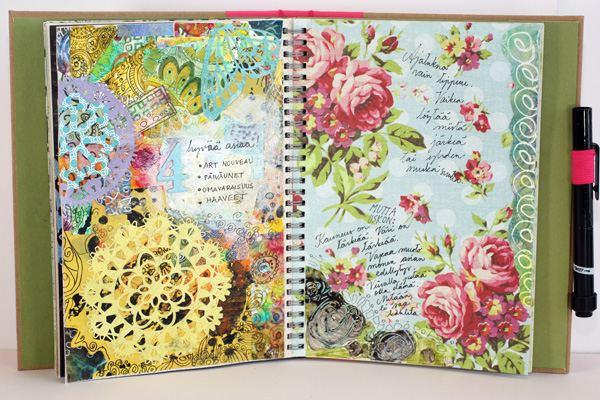Paint Brush Holders and Artful Woodworking
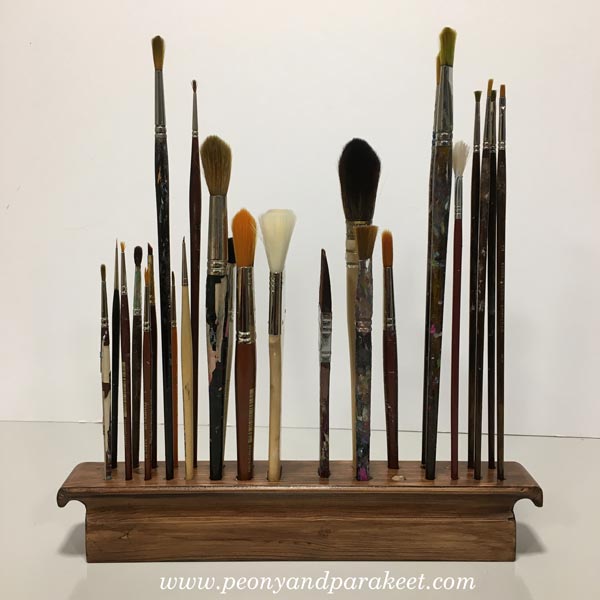
This blog post is dedicated to my skillful husband. He has always supported me as an artist. The support he has given to me hasn’t only been mental but practical as well. He has made countless of wooden items that I have needed for my art, using hand tools mostly. These projects often begin so that I carelessly draw something on paper and ask him to follow the drawing. My sketches inspire him to ask more questions, create prototypes, and when I see the final piece, it’s much more detailed and beautiful than I ever could imagine.
Paint Brush Holders
One of my favorite wooden treasures is the paint brush holder that can hold most of my brushes. It is designed so that I can put it on the shelf and then take it out when needed. I love seeing the brushes in one glance and storing them so that the bristles won’t pend. My original idea was just a simple wooden block with holes but my husband designed and finished the holder so that it’s like a valuable antique piece!
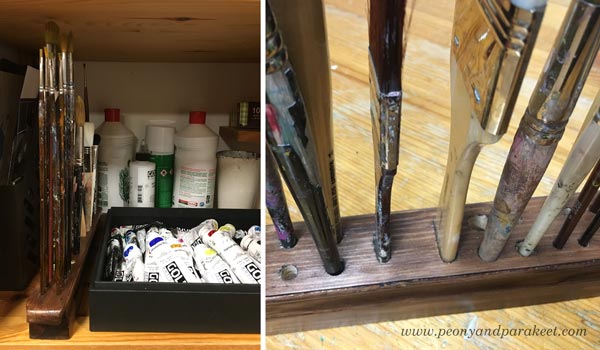
Because the vertical position ruins wet brushes, I always dry the brushes first. That gave me the idea of having a separate holder for wet brushes. “Something simple,” I said again. But my husband came with a better version. This beautiful paint brush holder can hold a lot of brushes in different sizes, and I love how practical the decorative holes are as well. The other side of the holder is slightly taller so that the brushes point downwards. It makes sure that the water won’t travel to the handle.
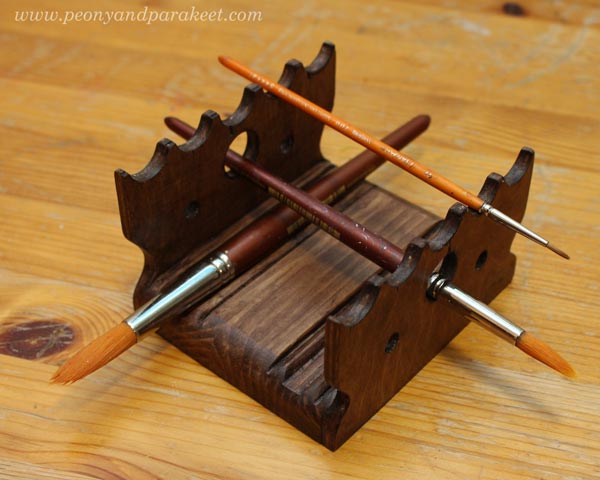
The Best Easel
We had an extra upright support of a shelving unit, and I wanted a new easel that would fit with the rest of the furniture in my studio. By adding one more leg and a holder for a painting, my husband turned the support into an adjustable easel!
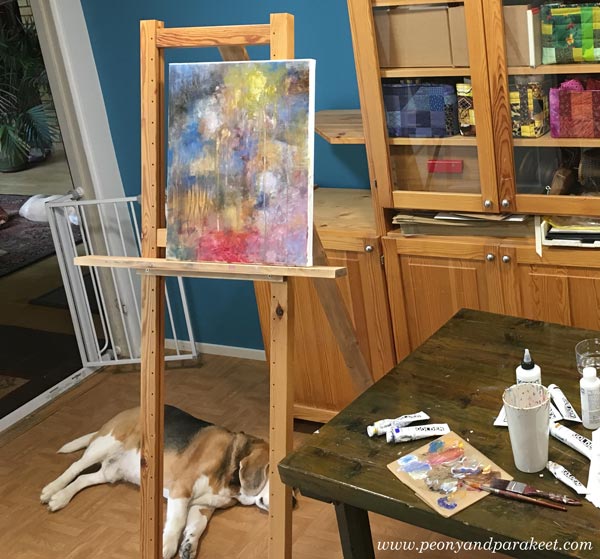
Light-Weighted Storage Box
My husband has made many storage boxes for the art supplies, and this is the newest one. It’s made from paulownia tree that comes from Asia, and it’s very light-weighted. I wanted this box look heavy but feel light, and my husband found the solution!
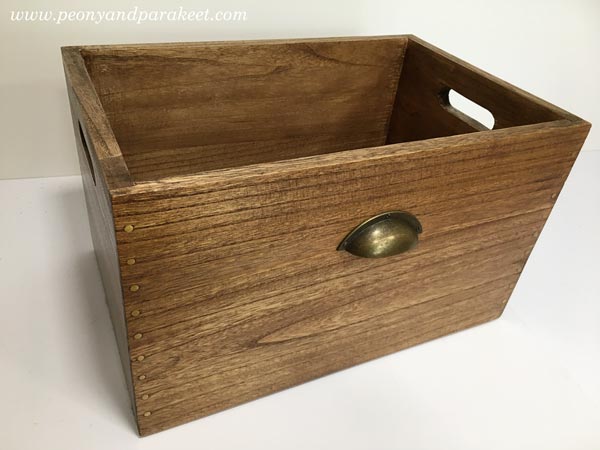
Perfectionist’s Wastepaper Basket
Much heavier but one of my ultimate favorites is the wastepaper basket made from oak. I think it’s luxurious and it makes me smile every time I see it. There’s some humor in living an imperfect life, creating imperfect art in the imperfect world – and having a perfect wastepaper basket!
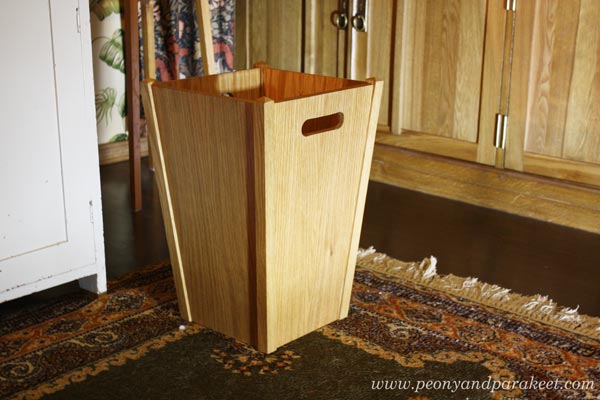
My Husband’s Journey as a Woodworker
When we were living in our previous home, there was no room for woodworking. About five years ago, we moved to our current house that has more space. That enabled my husband to start the hobby he had dreamed for a long time. Namely, for years he had watched woodworking videos from Youtube. While I was dreaming about the life as an artist, my husband sat on his computer and watched skillful woodworkers drill and plane. Based on the sounds of our small living room, it was like some serious wood projects were going on all the time.

Then, finally when he got his space, he was able to join the gang – get a collection of hand tools and make something beautiful that he can be proud. He thought that his skills would grow in a very short time – that he had learned the most of the necessary lessons by watching the videos. But as you may guess, it wasn’t that easy. He got disappointed. He drew a hole in a wrong place, he chose wood that wasn’t perfect for the project, he made errors when calculating the proportions, and he was surprised by the visual skills that the woodworking required. It was not only that his technical skills were lacking. His ability to balance his designs and to generate ideas for unique pieces were lacking too.
But I encouraged him to continue, and he did. Every project grew his skills. After a couple of years, he made a small table that shows how far he has come. It’s inspired by Japan and the early 20th century. It’s made from oak and finished with shellac.
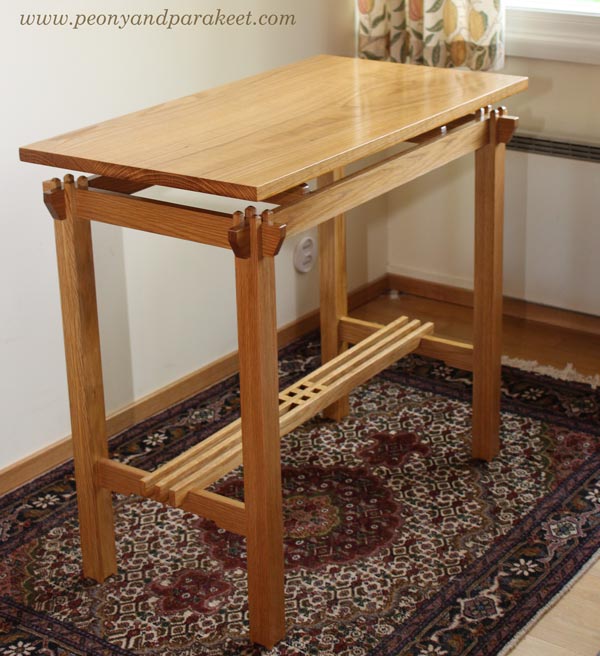
At the beginning of the hobby, my husband wanted to learn to carve. So the very first project of his was a wooden leaf. He started the carving, but it felt too difficult, so he gave up. After finishing the table, he remembered the unfinished project and completed it without struggles.
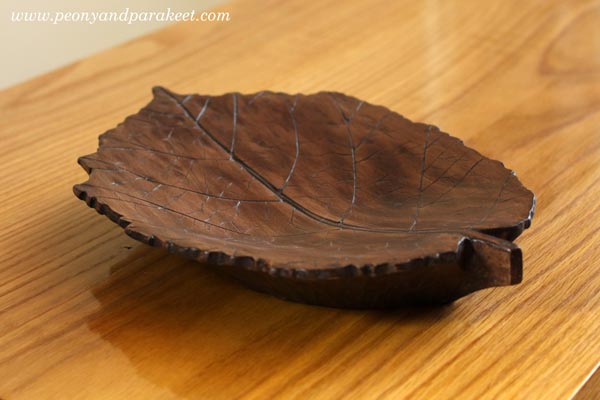
Even if this post was not directly about painting and drawing, I think that we all can relate to my husband’s journey. Creating art is never as easy in practice than in our dreams. But the happiness that it can bring is priceless. You just need to start and keep on creating!
Let me be your art teacher: Subscribe to my weekly emails!
Scrap Wood Collage

After working day and night with Folk Bag Workbook, it was time to relax. But honestly, I am not very good at doing nothing, so I decided to put my mind in rest by finishing the scrap wood collage. It is a project I have been making with my husband. I talked about the project first time in one of the video blog posts.
Background of the Project
While renovating the studio, we ran out of the ceiling panels. (You can see the hole in the ceiling on the video.) My husband had a box of wooden pieces collected from the past woodworking projects. We decided to use them to create an artwork together.
We had been talking about a project like this for a long time. My husband is an avid woodworker and I love to draw and paint. We are both extremely interested in art and design, so we thought this would be the perfect project for combining our strengths.
Planning
When the project started I drew some sketches and we discussed about them. I focused on the concept of how the wooden pieces should be arranged. I knew I wanted to include paint too, but was not too concerned about it yet. We agreed to create a sort of log cabin quilt type design and organize the wooden pieces by color. My husband drew the size of the artwork on the big piece of paper so that we could understand the proportions more accurately.
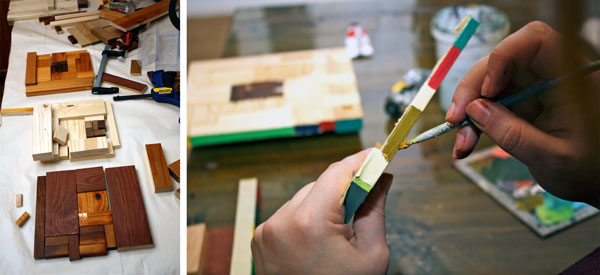
Making the Blocks
When we began to make the blocks, it dawned on us that I was too impatient to glue and adjust the pieces. And my husband had not much ideas about how the pieces should be composed visually. So I designed each of the block by organizing the wooden pieces on the table and my husband glued and finished the blocks. As every block is unique and most of the small wooden pieces are different sizes, my husband had a lot of work!
When all the blocks were glued, I wanted to add paint on them. I did not want to cover the wooden surfaces but add some color to the edges. As the theme of the studio is 1960s, I mixed colors from that era and painted each of the edges in different color.
Attaching the Blocks
After the blocks were painted, the artwork was ready to be put in place. My husband had made a wooden panel where he glued each of the blocks.

A Special Feature
If you watched the video carefully, you might have noticed that there is a power plug on the ceiling. The artwork is designed so that there is a flap in one of the blocks that can be slided away!
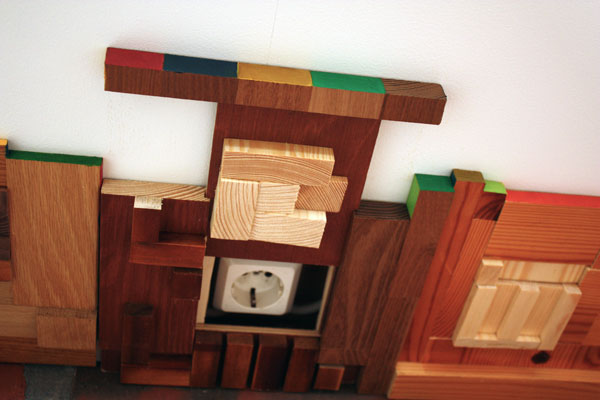
Lessons Learned?
All in all, this was a great project! This is what I learned here:
1) Let the creativity correct the mistakes.
We could have just ordered few more ceiling panels but we did the exact opposite!
2) Make it meaningful.
Many of the scraps carry memories themselves. And we created more memories by working together.
3) Search for new territories.
My approach for wood was totally different from traditional woodworker’s. The artwork was designed like a modern quilt even if it has been made from wood. For me, various wood species represented various colors. The wood grains were combined so that they formed rhytmic lines and ornaments. I also wanted to create a texture, but not by carving like a woodworker had done, but by playing with the height differences of each piece.
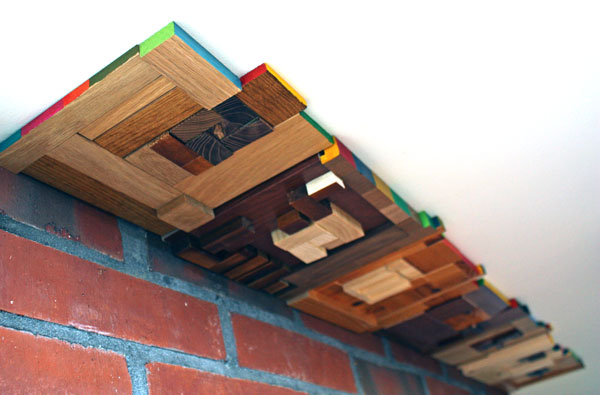
The fourth lesson is:
4) It’s good when it looks like it’s alive.
The end result might look terrible if you look at it like a traditional woodworker. While we made the project, my husband had some problems to get over the fact that every wooden piece does not fit exactly and there will be so much variety on the artwork. But in the end it all looks alive. I love the uneven, colorful edge. Combined with the texture, it all looks very organic even if there are clear, graphic blocks.
While creating this, I began to think of wood as a new art supply. Then I realized that most of the things in the world can be seen as an art supply! Mind-blowing, isn’t it!
P.S. Soon after we finished our artwork, my husband saw a woodworking video about making a wall-decoration from scrap wood. Does it differ from ours? Leave a comment and tell what do you think!
Video Blog: Paper Pieces, Wooden Pieces

I just finished this Mini Smash Book. You will see it in the video with art journal prompts that you can use for your journal. Before the journal I will show you my method for organizing decorated papers.
There’s also a wooden collage that I am working on with my husband!
Homemade Happiness
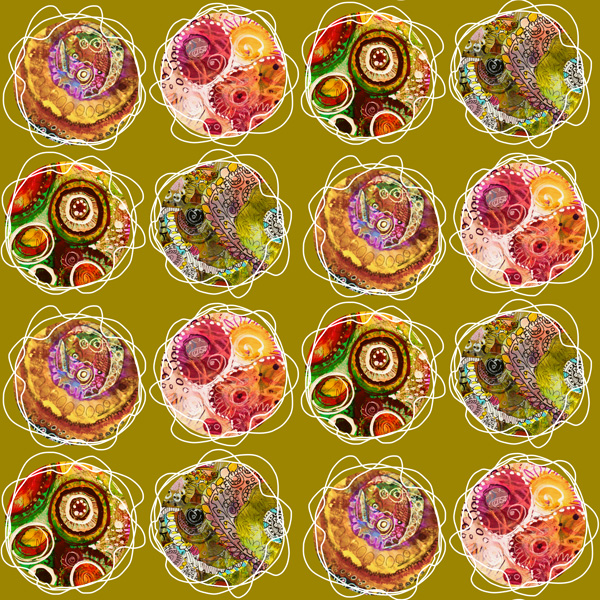
This is my new fabric pattern called “Homemade”. The happiness really starts from home and appreciating everything you already have.
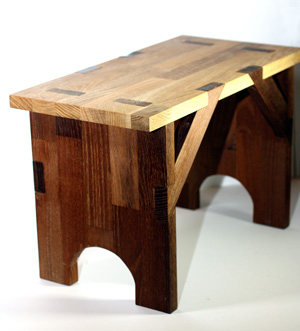 A stool that I am proud of
A stool that I am proud of
Our house is filled with little items that me or my husband have made. This year they have been especially important for me. Maybe because the winter has been so long and dark, with very few sunny days.
This stool is one of the little suns of our home. It has been made by my skillful husband. Every time I see it, I observe it’s brilliant structure and feel proud for his accomplishment.
Smash book continues
I have continued filling my Smash book with art journaling.
I do not mind the pages with preprinted assignments. They challenge me to get creative. Here I have expressed how I often see the images or colors when using my other senses.
 Good Distractions
Good Distractions
The world is sometimes too full of visual distractions for me! But they can be beneficial too. The yellow that I see when entering our home really makes me forget most of my worries.
I made a page about it and created a fantasy image of a house. It was so fun to make. What I love about art journaling is that everything can be taken as lightly or seriously as I want.
Recommend: Journal Fodder
I have bought a new art journal. It’s Dylusions journal with super thick pages. And I have also bought a new book: Journal Fodder. It is a great and detailed book about art journaling. The book includes techniques, prompts, ideas and is well structured. I love the combination of creativity and systemacy of it. See more information at the website of the authors: Journal Fodder Junkies Needless to say: will be spending a lot of time with art journaling this spring!
